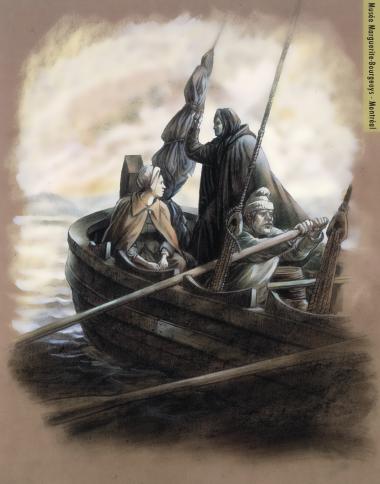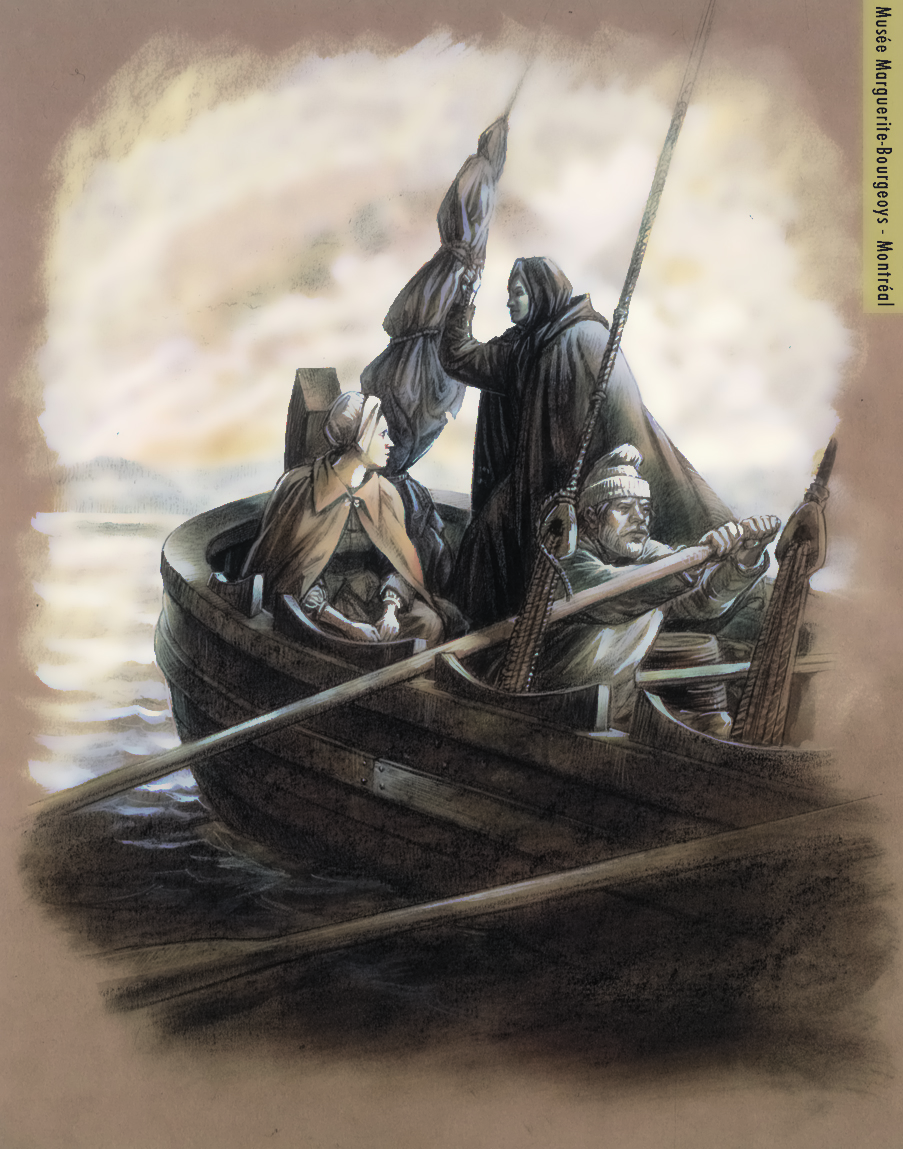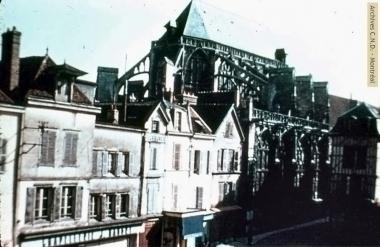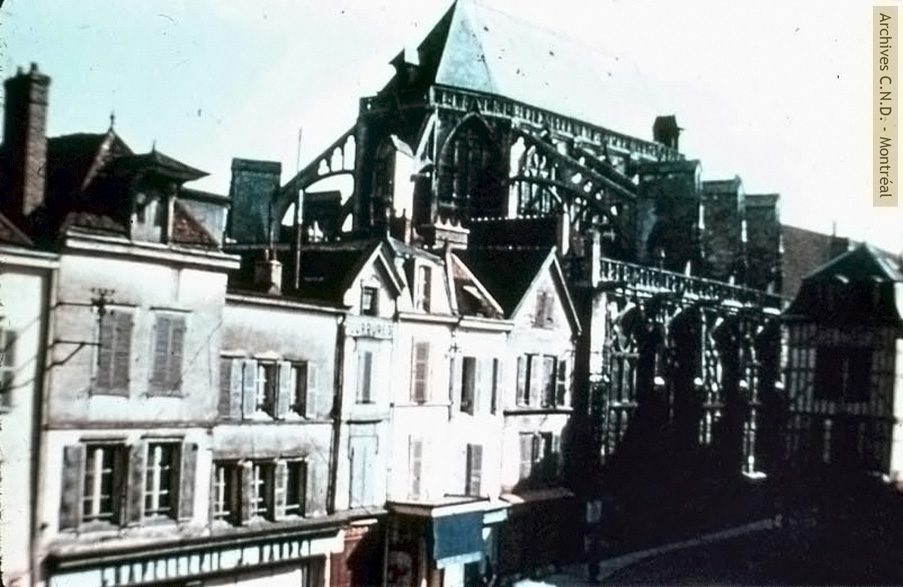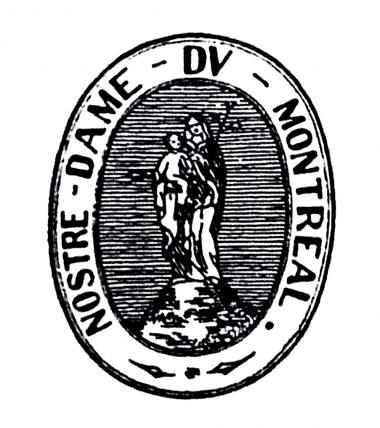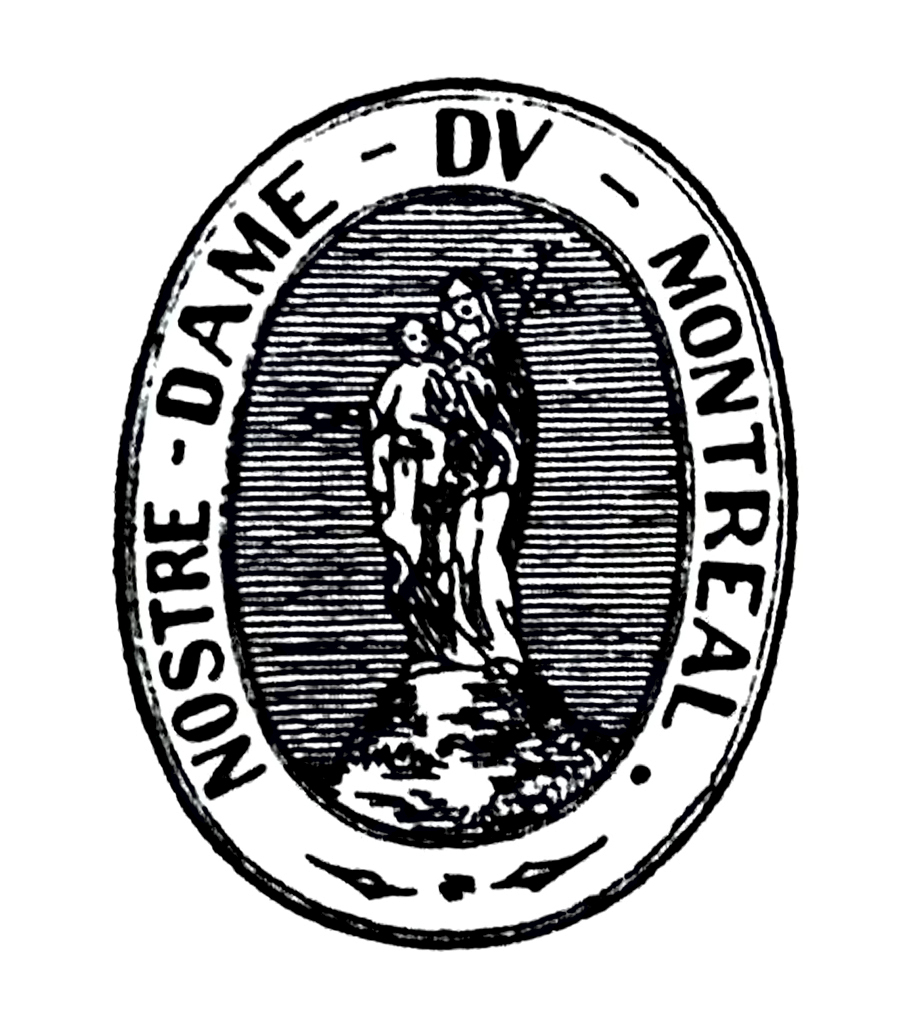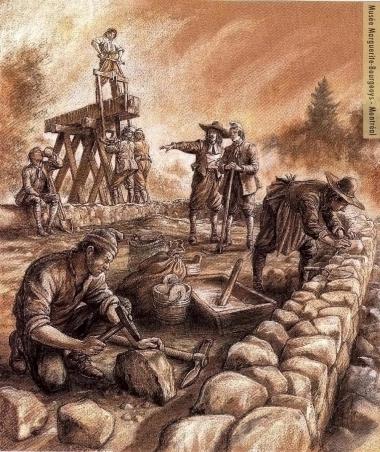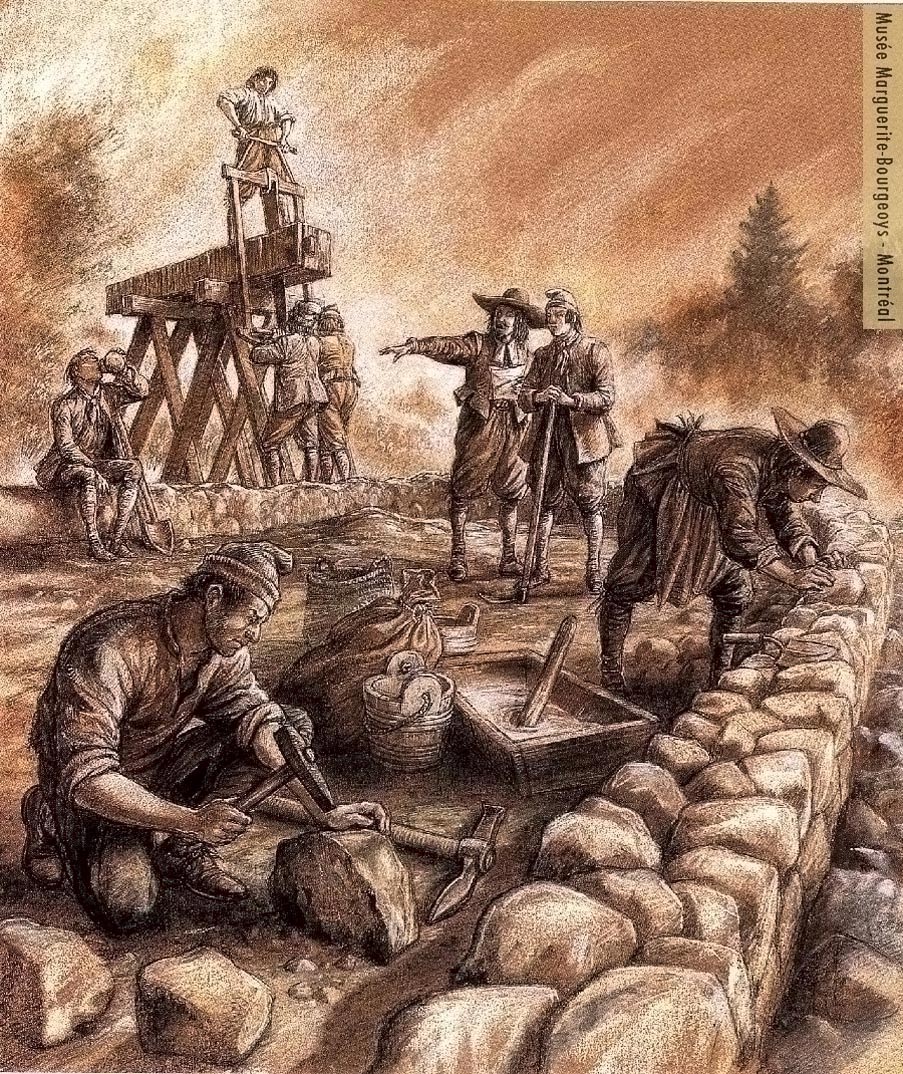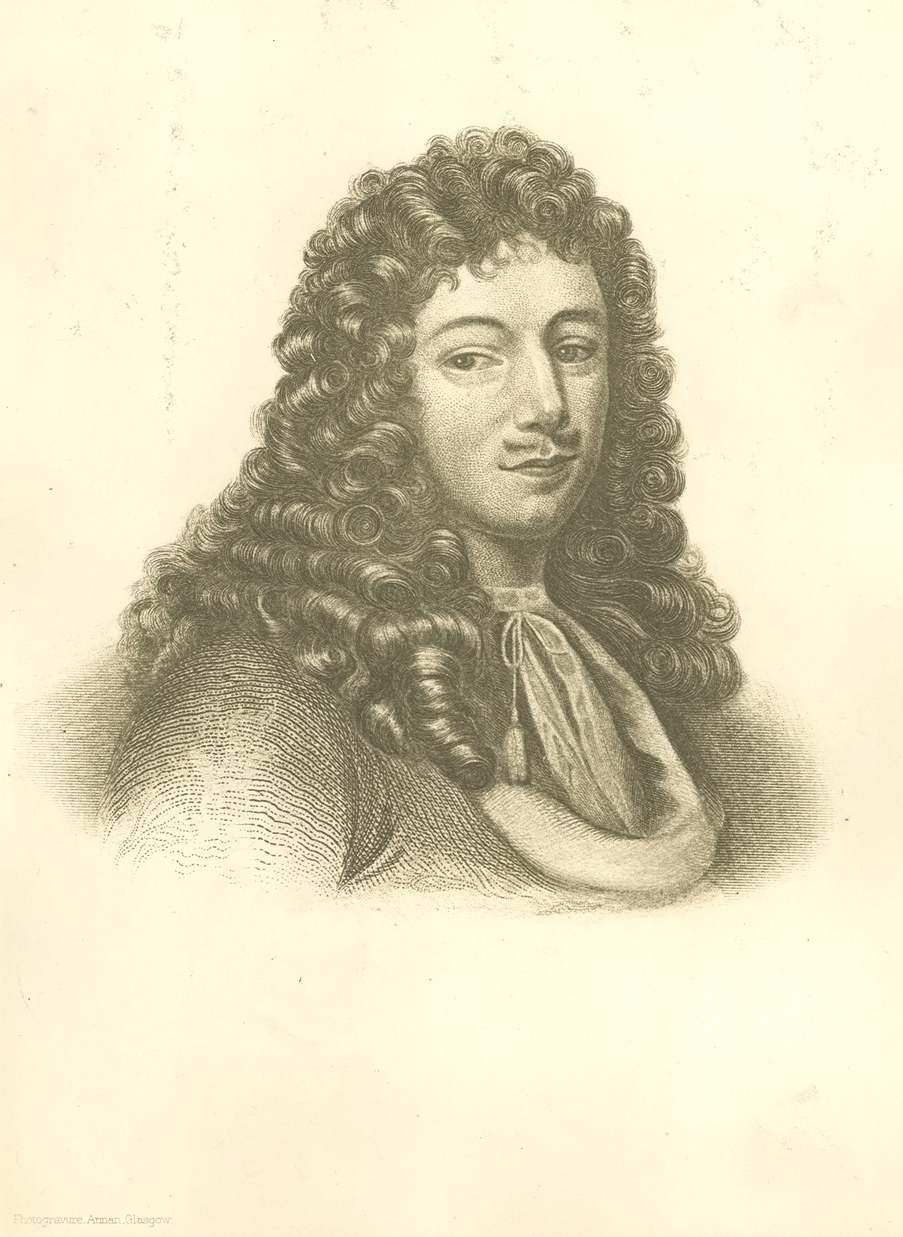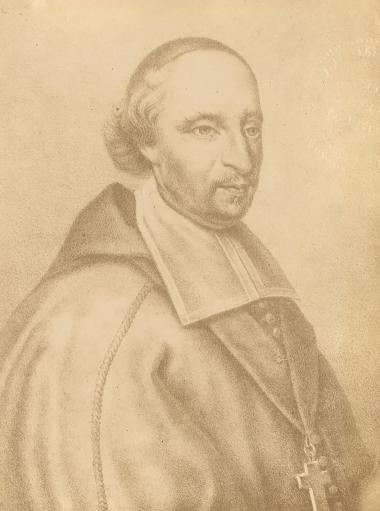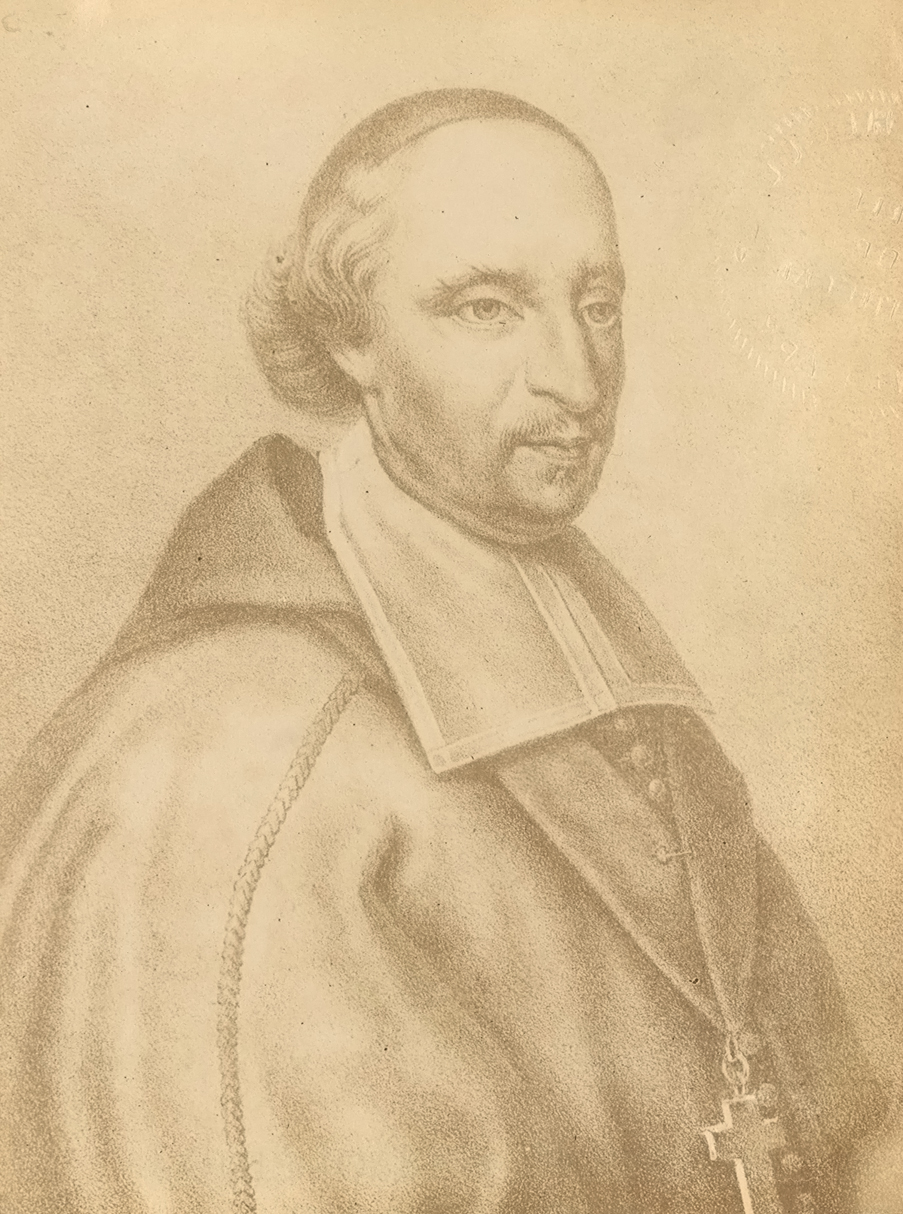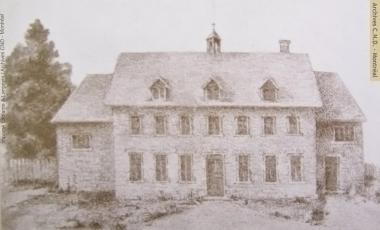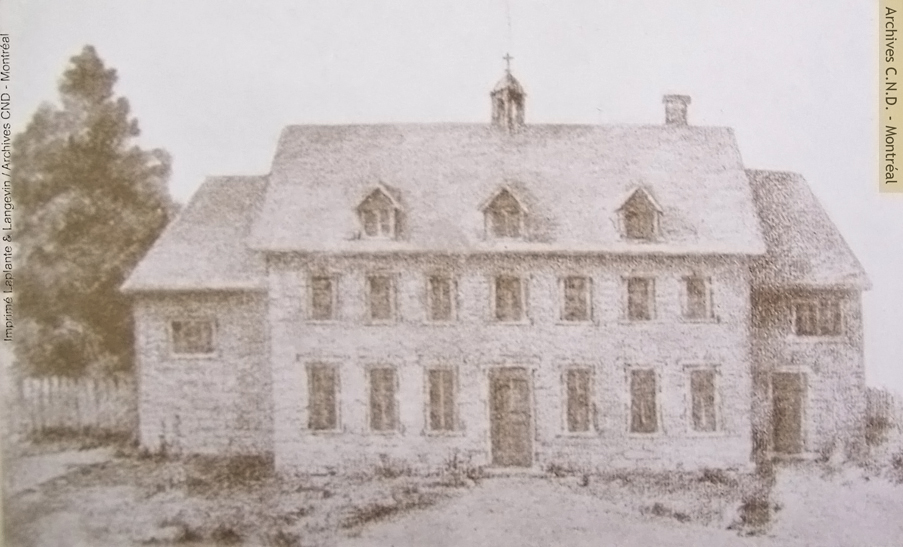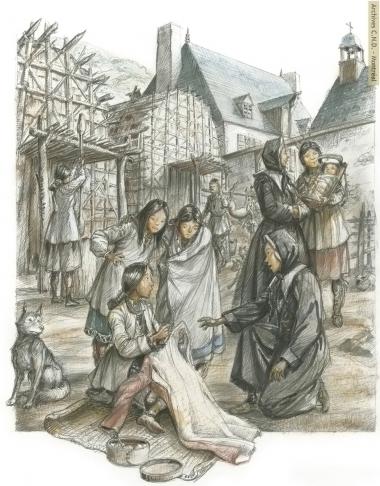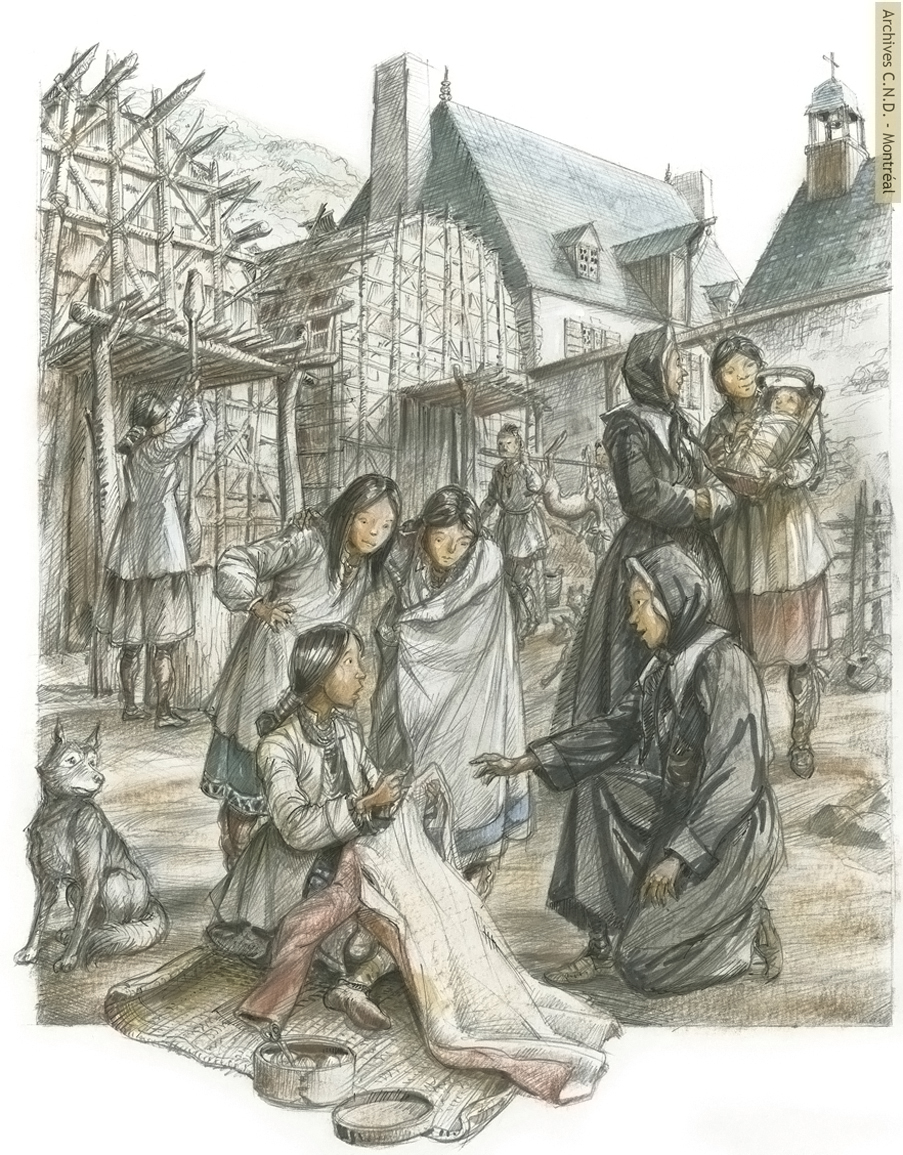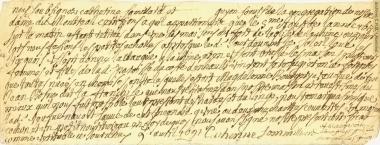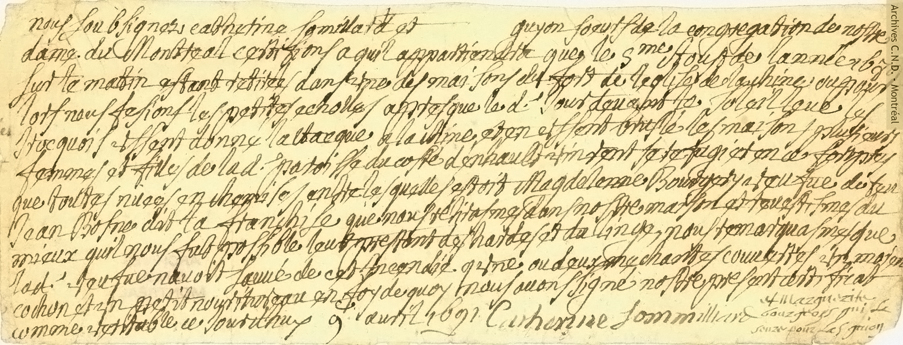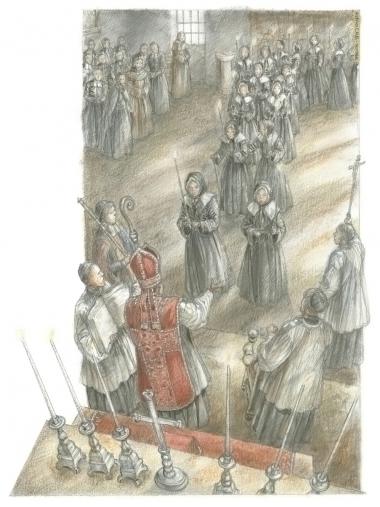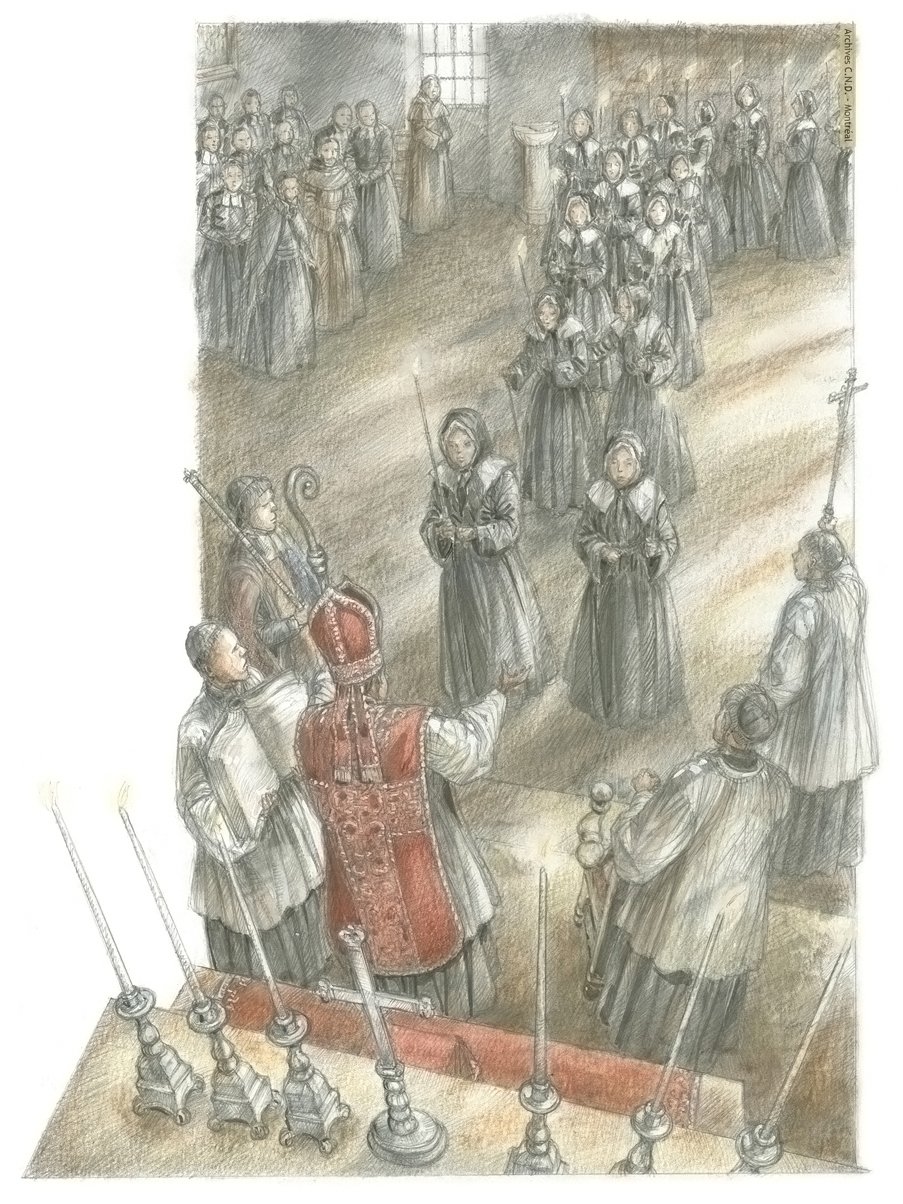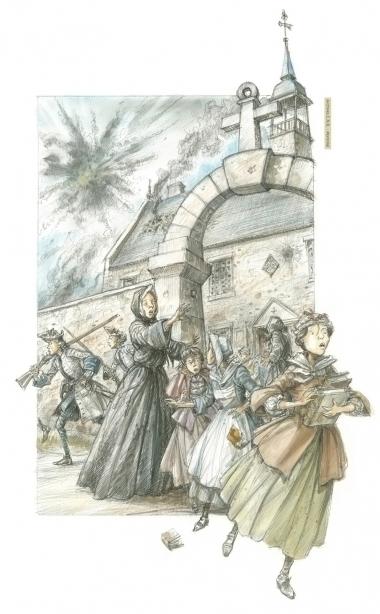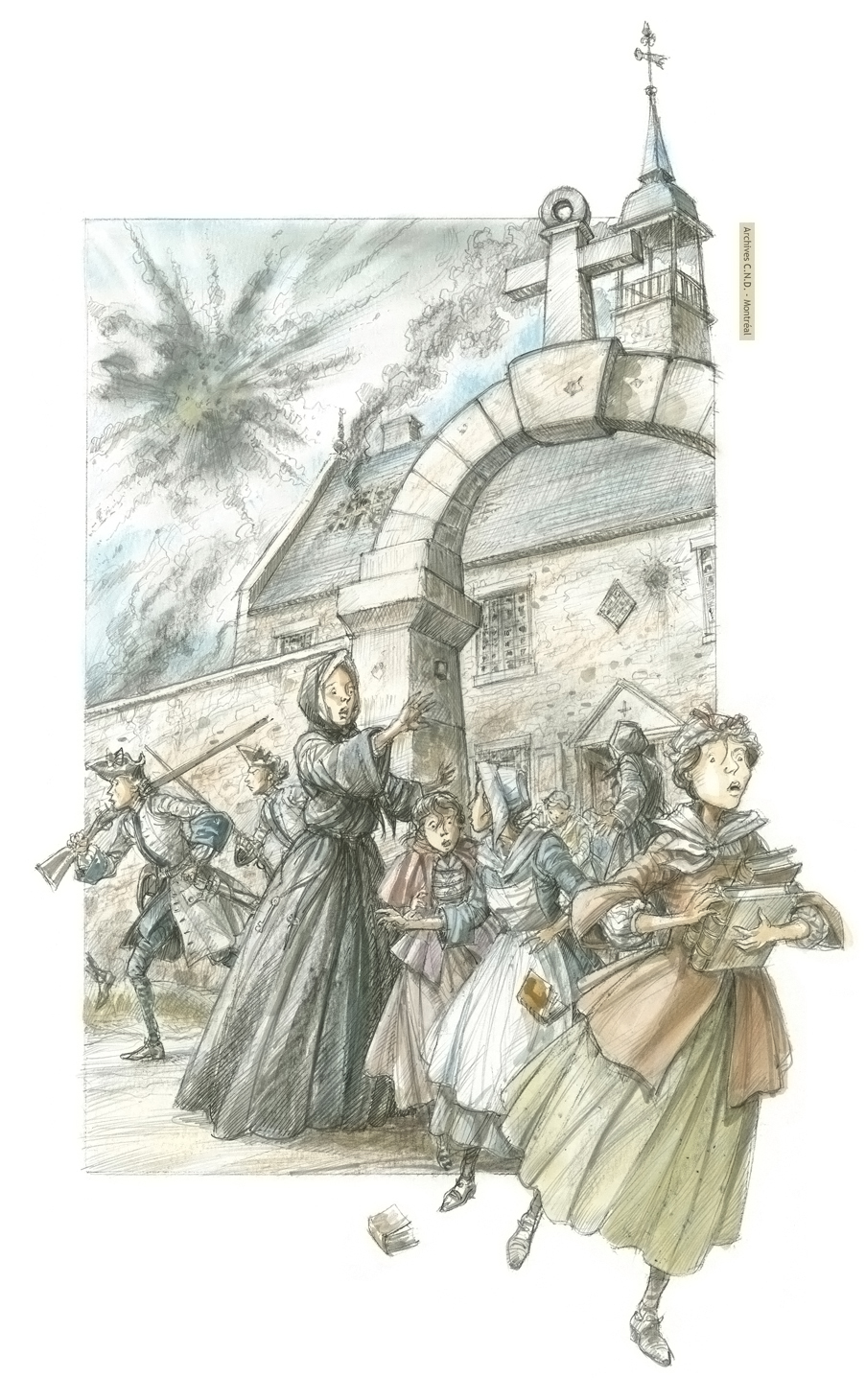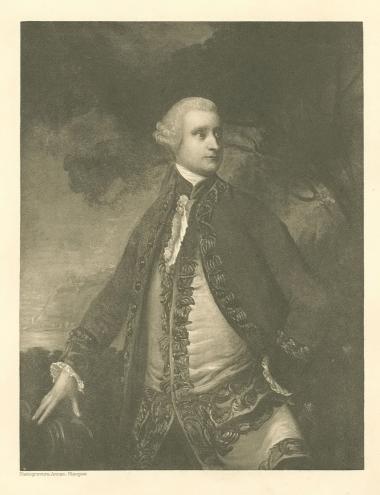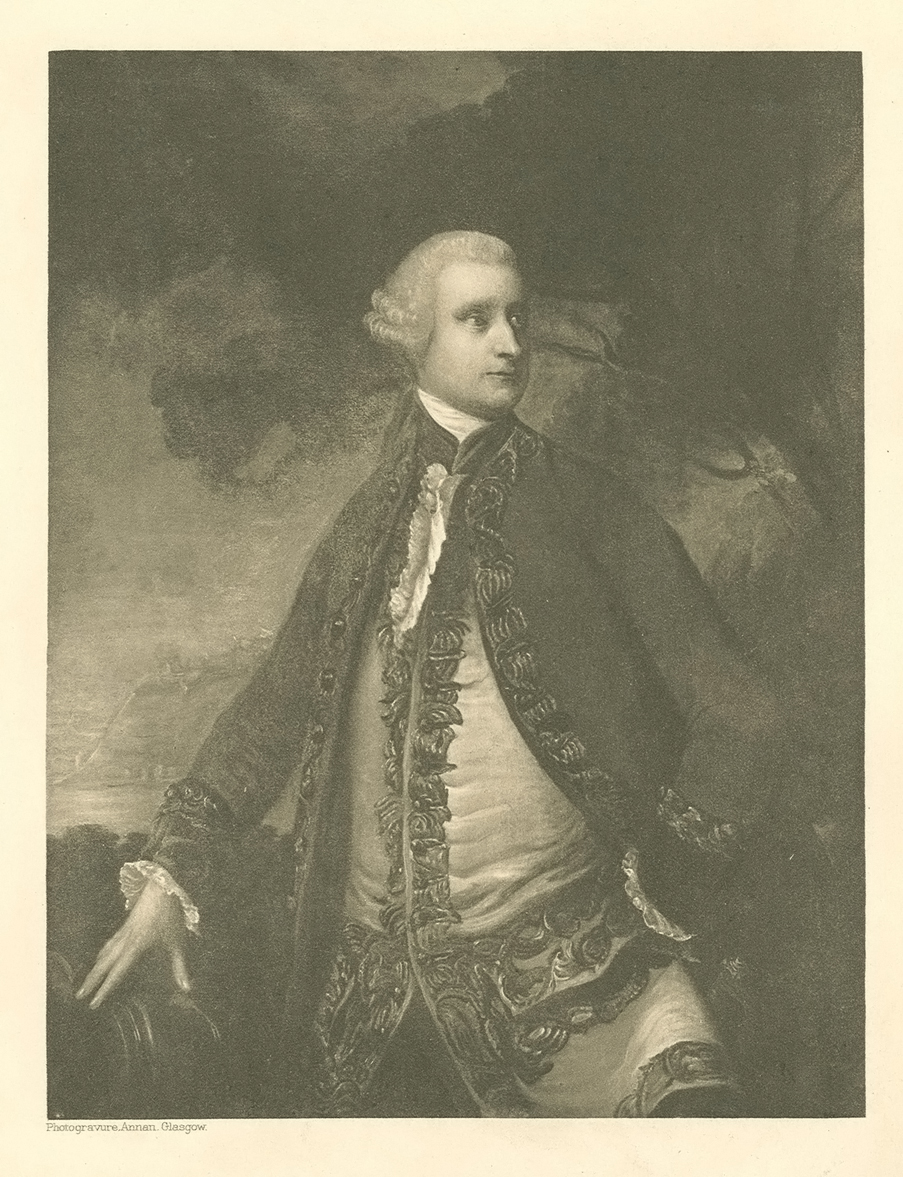Jacques Cartier plants a cross in Gaspé and takes possession of the territory in the name of the king of France.
Marguerite Bourgeoys (1620-1700)
New France (1534-1763)
France (17th and 18th Centuries)
1534
Jacques Cartier’s first voyage to Canada[16-]
The 17th century was “le Grand Siècle” for FranceIn the XVIIth century, the kingdom of France becomes a power whose political, intellectual and cultural influence spread across a large part of Europe all the way to North America. At the time, the history of France is marked above all by the rise and the peak of “absolute power” of royalty. A strong movement of evangelization and Christian renewal is also developing. France is shining in all cultural domains that it supports through the creation of academies: literature, the arts (painting, sculpture, architecture, music) and sciences (astronomy, mathematics, physics, botany).
1604
First French settlement in AcadiaThe first French colony in North America is established on Saint Croix Island in Acadia by Pierre Du Gua de Monts, accompanied by Samuel de Champlain.
1608
Founding of QuebecSamuel de Champlain founds Quebec City. This marks the beginning of French colonization in the St-Lawrence Valley. Champlain dreams of expanding the territorial empire of France and enriching it through the fur trade.
1610
Death of Henry IV and crowning of Louis XIIILouis XIII is only nine years old when his father dies and he is crowned king of France and Navarre. His mother, Marie de Medicis, governs the kingdom as regent. She does not manage affairs very well. In addition, her pro-Italian and pro-Spanish policy bothers many, beginning with the young king. In 1617, Louis XIII ousts Marie de Medicis and she is sent into exile. The king then obtains full power.
1615
Arrival of the RécolletsThe Récollets are Catholic missionaries placed in charge of the religious education of the French settlers and the evangelization of the Amerindians.
1618-1648
Thirty Years’ WarThe Thirty Years’ War is a political and religious conflict that first set the German Protestant princes against the power of the Catholic Emperor. It then takes on European dimensions as the kings and princes of the different kingdoms intervene in the conflict. This war tears Europe apart. It finally ends with the signing of the Treaties of Westphalia.
1620
Birth of Marguerite BourgeoysMarguerite Bourgeoys is born in Troyes, France.
1624
Nomination of Cardinal Richelieu as Chief MinisterArmand Jean du Plessis de Richelieu is very involved in affairs of the state. He shares with King Louis XIII the same ideas of grandeur for France.
1625
Arrival of the Jesuits in QuebecThe missionary Jesuits arrive in Quebec to evangelize the Amerindians. In 1653, they found Collège de Québec where they offer classical education to young French settlers.
1627
Founding of the Company of One Hundred AssociatesThe Company of New France or of One Hundred Associates groups together one hundred merchants and aristocrats. Its mandate consists of promoting the colonization of New France in exchange for a monopoly of the fur trade.
1634
Founding of Trois-RivièresTrois-Rivières is the second oldest city in Canada. Quebec is the oldest city. Trois-Rivières, located at the confluence of the St-Lawrence and the three channels of the Saint-Maurice River, is strategically important to the fur trade. This is why Samuel de Champlain, with the intention of occupying the territory and ensuring the fur trade, confides the building of a fort to Laviolette.
1639
Arrival of the Ursulines and the Augustinian Hospitallers in QuebecThe Ursulines teach young girls at their house in the Lower Town of Quebec. The Augustinian Hospitallers found the Hôtel Dieu de Québec Hospital to treat the inhabitants and the native people of the area.
1641
Beginning of the first war between the Iroquois and the FrenchThe French and Iroquois War lasts 25 years despite numerous peace treaties.
1642
Founding of Ville-Marie (Montreal)Paul de Chomedey de Maisonneuve and Jeanne Mance, with some fifty other people, found Ville-Marie (Montreal). The religious ideal of the Société de Notre-Dame de Montréal inspires the establishment of the colony. The Island of Montreal is a favourable place to establish a village which rapidly becomes the fur trade hub in New France. Jeanne Mance also founds the Hôtel-Dieu de Montréal, the second hospital in New France. She administers the hospital until her death.
1642
Death of Richelieu and Mazarin’s entry into the Council of StateA naturalized French citizen in 1639, Giulio Mazzarini places himself at the service of King Louis XIII and of Cardinal de Richelieu, his mentor and friend. He is appointed Cardinal de Mazarin and later succeeds Richelieu as Chief Minister.
1643
Death of Louis XIII and coronation of Louis XIVThe future Sun King is crowned at five years of age. During the regency of Anne of Austria, widow of Louis XIII and mother of Louis XIV, Mazarin rules France. Despite strong opposition, he remains Chief Minister until his death.
1648-1653
The FrondeThe Fronde is the last great period of political turmoil the French monarchy faces before the Revolution of 1789. It constitutes a complex mixture of serious economic crises, parliamentary protests, mass revolts and conflicts with the nobles. Peace is re-established in Paris in 1652; the return of Mazarin in 1653 restores order and calm elsewhere in the kingdom.
1653
Arrival of the “Grande Recrue”In 1653, and again in 1659, the arrival of some one hundred new colonists revives the colony. They commit themselves to clearing the land they have been granted.
1653
Arrival of Marguerite Bourgeoys in Ville-Marie (Montreal)Marguerite Bourgeoys arrives in New France with the “Grande Recrue”. Her objective is to open a school. When she arrives in Montreal, there are still too few school-aged children for her to carry out her goal.
1655
Première tentative de construction de la chapelle Notre-Dame-de-Bon-SecoursMarguerite Bourgeoys begins construction of Notre-Dame-de-Bon-Secours Chapel, but work is suspended in 1657. Marguerite Bourgeoys will have to wait more than 20 years before her dream is realized.
1657
Arrival of the Sulpicians in Ville-Marie (Montreal)The Sulpicians are teachers and missionaries. In 1663, four priests arrive in Ville-Marie and become feudal lords of the Island of Montreal. They play a leading role in the religious, economic, political, cultural, architectural and urban development of Montreal.
1658
Opening of the stable-schoolMarguerite Bourgeoys opens the first school in Ville-Marie in a former stable. The children helped clean and prepare their school.
1658-1659
First voyage to FranceMarguerite Bourgeoys, accompanied by Jeanne Mance, makes her first voyage back to France. Marguerite returns to Ville-Marie (Montreal) with four recruits.
1659
Nomination of the first bishop of Quebec: Bishop de LavalFrançois de Montmorency de Laval is ordained priest in 1647 and is named Apostolic Vicar of New France and Bishop of Petra in 1658. Known for his piety, humility and kindness, he actively participates in the life of the colony. He begins the Séminaire de Québec. In1674, Quebec becomes a diocese and he becomes the first bishop of Quebec.
1659
Arrival of the Hospitallers of St Joseph at the l'Hôtel-Dieu de MontréalThree “Filles de Saint-Joseph de la Flèche” – Sisters Judith Moreau de Brésoles, Catherine Macé and Marie Maillet, come to Ville-Marie to care for the sick and the wounded at l’Hôtel-Dieu.
1659
Peace of the PyreneesThe treaty puts an end to the war between France and Spain that began in 1635. The reconciliation of the two main powers in Europe, the work of Cardinal de Mazarin, results in the marriage of the young Louis XIV with Maria Theresa, daughter of the king of Spain. After the Peace of the Pyrenees, the Kingdom of France asserts itself as a power that extends over a large part of Europe.
1661
Death of Cardinal Mazarin and the beginning of the true reign of Louis XIVThe day after the death of his Chief Minister, Louis XIV, then 22 years old, begins his personal reign. Breaking with royal tradition, he rules with a reduced Council and is directly involved in affairs of the State.
1661
Colbert enters into the service of Louis XIVJean-Baptiste Colbert is named Minister of Finances of France. Louis XIV and Colbert adopt mercantilism: an economic system that aims at developing foreign trade to enrich the nation. They also favour the interventionist economic policy which increases State participation in the economy. They thus found several large royal factories.
1663
Severe earthquakeA very severe earthquake provokes land cave-ins, crevasses, river diversions, cabins to collapse, etc. In the seven months following the earthquake, aftershocks will be felt across Eastern North America.
1663
Beginning of the Royal ProvinceLouis XIV places New France under his direct authority and reforms the government of the colony along the lines of the government of France. Jean-Baptiste Colbert, the French minister of finance, is placed in charge of reorganizing and developing New France.
1663-1673
Arrival of the “King’s Ward”Approximately 800 young French women, often orphans, arrive in New France to marry and start a family. The royal treasury pays for their voyage, provides them with a dowry and helps them get established. This policy aims at substantially increasing the population of the colony and encouraging its development.
1665
Arrival of the intendant TalonJean Talon is the first intendant of New France. He fulfils two mandates: from 1665 to 1668 and from 1670 to 1672. Appointed by Louis XIV and his minister of finance, Jean-Baptiste Colbert, Jean Talon establishes many reforms that aim at boosting the population and the economic progress of the colony. Thanks to the efforts of Colbert and Talon, the population of New France will at least double.
1665
Arrival of the Carignan-Salières Regiment in QuebecThe Carignan-Salières Regiment has 1200 men. Its mission is to defend the colony and invade the Iroquois. It builds several forts along the Richelieu to drive back the raiding Iroquois who are allied with the English. When this mission is accomplished, approximately 400 soldiers choose to remain in the colony. Many of them are bachelors ready to be married. These soldiers help increase the population of the colony.
1667
Beginning of the French-Iroquois peaceSince the beginning of New France, the settlers are in constant danger of being pillaged or killed by the Iroquois. The Iroquois wars lead to the assimilation of several native tribes or to their dispersal across North American territory. The peace treaty signed in 1667 ensures the French colony of approximately fifteen years of relative peace
1669
Permission to teach is given to the “Filles séculières de la Congrégation de Notre-Dame”Bishop François de Laval gives Marguerite Bourgeoys and her companions permission to teach wherever they are needed in his diocesewhich comprises all of New France.
1670-1672
Second voyage to FranceMarguerite Bourgeoys returns to France a second time to promote her plan for an uncloistered community.
1670
Creation of the Hudson’s Bay CompanyThe Hudson’s Bay Company originates in London as a result of the rivalries between France and England over the fur trade in North America. After failing to interest the French Crown in their project, Médard Chouart des Groseillers and Pierre-Esprit Radisson convince Charles II, King of England, to found such a company. It is one of the oldest companies in the world that is still in business.
1671
Congrégation de Notre-Dame (CND) obtains Letters PatentThe “Institut des Filles séculières de la Congrégation de Notre-Dame” obtains Letters Patent signed by King Louis XIV.
1672
Arrival of Governor General Louis de FrontenacKing Louis XIV names Louis de Buade, Count of Frontenac and of Palluau, Governor General of New France. He governs until 1682 and then again from 1689 until his death in 1698. He develops the colony and engages in a series of battles against the English and the Iroquois. He is the author of the famous expression: “I have no reply to make to your general other than from the mouths of my cannons and muskets.”
1672-1718
Exploration of the Mississippi and founding of LouisianaIn 1673, Louis Jolliet and the Jesuit Father Jacques Marquette explore the Mississippi River in search of a passage to China. In 1682, Cavelier de la Salle and Henri de Tonti explore the entire river all the way to the Gulf of Mexico. LaSalle takes possession of the land he names Louisiana in honour of the King Louis XIV. The French empire in America thus extends from Quebec to the Mississippi delta. In 1699, Pierre Le Moyne d'Iberville, in turn, travels to the mouth of the Mississippi. Almost twenty years later, Jean-Baptiste Le Moyne de Bienville founds New Orleans.
1673
Second CND Mother HouseMarguerite Bourgeoys has an addition built onto the stable-school (which is considered the first CND Mother House). This building becomes the second Mother House of the Congregation.
1674
Arrival of the French and English on the African CoastsDuring the XVIIth and XVIIIth centuries, millions of African slaves are deported to South America, the Caribbean Islands and North America. The slave trade is primarily aimed at providing cheap labour for the Spanish, Portuguese, Dutch, English and French colonies, particularly for working in sugar cane plantations. The French operate mainly in Senegal and on the Ivory Coast.
1676
Canonical approbation of the CNDAfter having given Marguerite and her companions permission to teach in his diocese (which comprises all of New France), Bishop de Laval officially approves the “Institut des Filles séculières de la Congrégation de Notre-Dame.”
1676
Teaching begins at the Mountain MissionCompanions of Marguerite Bourgeoys begin teaching young Amerindians at the Mountain Mission on Mont Royal (a wild forest at the time).
1678
Opening of Notre-Dame-de-Bon-Secours ChapelMarguerite Bourgeoys sees one of her dreams come true: the first stone church in Ville-Marie (Montreal) is finally opened after three years of construction. It is completely destroyed by a terrible fire in 1754 and then rebuilt between 1771 and 1773.
1679-1680
Third voyage to FranceIn her lifetime, Marguerite Bourgeoys crosses the Atlantic Ocean seven times, a particularly daring odyssey in the XVIIth century.
1683
CND Mother House is destroyed by fire1684
Establishment of the third CND Mother HouseThe third Mother House of the Congregation is built on Notre-Dame Street. It is destroyed by fire in 1768. In total, over the years, there will be eight different Mother Houses.
1685
Revocation of the Edict of Nantes by the Edict of FontainebleauLouis XIV wants to unify his subjects under one common religion and takes measures to suppress Protestantism. He revokes the Edict of Nantes, issued by Henry IV in 1598, granting religious freedom to the Protestants. The revocation provokes the exodus of 150,000 to 200, 000 Huguenots. Among them are several craftsman, merchants, officers and scholars. A large number of Huguenot combatants from the British colonies will take part in the Conquest of New France in 1759-1760.
1689-1697
War of the League of AugsburgIn 1689, numerous European States, including England and Holland, ally themselves to confront France. They are worried about the ambitions of Louis XIV and his increasing conquests. The battles spread into the American colonies of France and England.
1689
Lachine MassacreFrance and England declare war on each other. In 1689, Iroquois warriors, allied with the English, make a surprise attack on the settlement in Lachine west of Montreal. Barns and houses are burnt down. Some ninety people, both men, women and children, are killed or abducted.
1690
Failed attack on Quebec by the EnglishAfter seizing Fort Pentagouet and Port-Royal in Acadia, the enormous fleet of at least 30 ships commanded by Admiral William Phips, travels up the St. Lawrence and besieges Quebec, whose defences are organized by Frontenac. The reinforcements from Montreal led by Louis-Hector de Callière arrive on time. Despite two or three days of bombardment, the attack on Quebec fails. The English negotiate the exchange of prisoners and cast off.
1692
Madeleine de Verchères heroically defends Fort de VerchèresMarie-Madeleine Jarret de Verchères, la fille du seigneur, est âgée de 14 ans quand la seigneurie est victime d’une attaque iroquoise en l’absence de ses parents. Ayant hérité de la bravoure de sa mère, elle échappe à un guerrier qui la poursuit et parvient à s’enfermer dans le fort. Avec détermination, Madeleine organise la défense. Elle réussit à tenir en respect les assaillants pendant huit jours, jusqu’à l’arrivée de renforts.
1693-1694
Misery across the countryFrance goes through a serious economic crisis due to bad climatic conditions that destroy the crops. Epidemics ravage the kingdom killing almost 10 percent of the population.
1693
Election of the second superior of the CNDMarie Barbier (Sister de l’Assomption), first Sister of the Congregation born in Montreal, succeeds Marguerite Bourgeoys as superior.
1697
Signing of the Treaty of RyswickThe Treaty of Ryswick settles the War of the League of Augsburg. Louis XIV recognizes William III as King of England. The treaty also stipulates that the territorial borders of France and England in America (mainly the trading posts) be returned to where they had been before the war.
1698
Acceptance of the rules by the Congrégation de Notre-Dame and first religious professionThe rules written by Bishop de Saint-Vallier are accepted by the members of the Congregation. The first religious professions take place in Ville-Marie (Montreal) and Quebec.
1699
Nomination of Louis-Hector de Callière as governorAfter Frontenac’s death in 1698, Louis XIV names Louis-Hector de Callière Governor of New France.
1699
Smallpox epidemic in Ville-Marie (Montreal)There are over 100 smallpox victims.
1700
Death of Marguerite Bourgeoys in Ville-Marie (Montreal)Marguerite Bourgeoys dies at age 79. The only portrait of Marguerite Bourgeoys is sketched at her wake and painted in the weeks that followed. This painting can be contemplated at the Marguerite-Bourgeoys Museum in Montreal.
1701-1713
War of the Spanish SuccessionThe succession to the Spanish throne triggers a war in which France and Spain face off against a European coalition. Armed conflict extends all the way to North America where New France and the British colonies confront each other. The British troops try in vain to conquer Montreal and Quebec.
1701
Great Peace of MontrealAt the initiative of Louis-Hector de Callière, the Great Peace Treaty of Montreal is signed by France and by 39 Amerindian nations, putting an end to the third Iroquois war which began around 1684. The Agniers agree to remain neutral in the conflicts between the French and the English. This peace agreement relieves the colony of the constant threat that weighs on it and allows New France to develop and fortify itself.
1703
Another smallpox epidemic in MontrealThis time, over 250 people die on the Island of Montreal.
1711
Another failed attack by the English on QuebecAround 1710, France and Great Britain declare war on each other. In order to take over New France and its fur trade, the English plan a new attack on Quebec. Despite Admiral Hovenden Walker’s sizeable fleet and army, the attempt fails when seven ships sink on the North coast of the Gulf of the St. Lawrence. The inhabitants of Quebec mark the event by renaming Notre-Dame-de-la-Victoire Church (Our Lady of Victory), given this name after the Phips siege in 1690, as “Notre-Dame-des-Victoires” (Our Lady of Victories).
1713
Signing of the Treaty of UtrechtThe Treaty of Utrecht brings an end to the War of the Spanish Succession and is a setback for the French. France agrees to give up all of its claims to the areas around Hudson Bay, Newfoundland, and Acadia. Thirty years of peace follow the signature of the Treaty of Utrecht.
1715
Death of Louis XIV – RegencyAfter the death of Louis XIV, his great-grandson, who is only five years old, succeeds him to the throne. Philippe d’Orléans, nephew and son-in-law of the dead king, rules on behalf of the young monarch. During the regency, the Duc d’Orléans implements several reforms.
1721
Fire in MontrealA devastating fire in the Place du Marché and Hôtel-Dieu district destroys half the city (171 houses burn down). Intendant Michel Bégon sets a new regulation: all new houses built within the city walls must be built of stone. This regulation contributes to the development of faubourgs outside the fortifications. In 1734, another fire ravages Montreal on St. Paul Street. Within three hours, 46 houses are destroyed, including the Hôtel-Dieu which has just been rebuilt.
1723
The taking of power by Louis XVThe taking of power by Louis XV At age 13, Louis XV officially takes power. He takes little interest in political matters and successively delegates the management of the kingdom to the Duc de Bourbon, Cardinal André-Hercule de Fleury and the Duc de Choiseul. The dominance of France in Europe slowly declines.
1730
Creation of the Forges Saint-MauriceForges Saint-Maurice is created near Trois-Rivières and forms the first iron industry in Canada. For 100 years, the ironworks remains the most technologically advanced in America. Iron production begins in 1738 and continues until the forges shut down in the late XIXth century.
1744-1748
War of the Austrian SuccessionThe lack of a male heir after the death of Emperor Charles VI of Austria in 1740 leads to a race for succession. France and England both support a different candidate for the imperial throne. In 1744, after 30 years of peace, France is again at war with England. Once again, the conflict spreads to America. Military operations are centred in the Gulf of St. Lawrence around the Fortress of Louisbourg.
1745
First Siege of LouisbourgThe Fortress of Louisbourg is founded in 1713 by the French. It becomes the capital of Île Royale (Cape Breton Island) in 1718. In 1745, a New England colonial force aided by a British fleet captures Louisbourg after a 47 day siege. The Sisters of the Congrégation de Notre-Dame, their students and families are deported to France. Louisbourg is returned to France in 1748 after the Treaty of Aix-la-Chapelle that ends the War of the Austrian Succession.
1755
Deportation of the AcadiansOn a ruling issued by the Nova Scotia Chief Justice, the British deport, without warning, between 6,000 and 7,000 Acadians to France and to the American colonies. They are accused of not assimilating fast enough and of not being good subjects of the British sovereign.
1756-1763
Seven Years’ WarUnlike the other conflicts, the hostilities between England and France begin in the colonies in 1754. The Seven Years’ War breaks out in Europe in 1756. Several countries ally themselves with either France or England according to their interests. The Treaty of Paris is signed in 1793 ending the Seven Years’ War. England then officially takes possession of New France.
1758
Second Siege of LouisbourgOnce again Louisbourg surrenders to the English under the command of Jeffrey Amherst. The siege lasts seven weeks. The British forces count 27,000 soldiers and seamen against 6,000 for the French and 39 ships against 10 vessels. Once again, the Sisters of the Congrégation de Notre-Dame, their students and families are deported to France. The fortress is destroyed two years later.
1759
Battle of the Plains of Abraham (Taking of Quebec)The city is bombarded relentlessly, day and night, for two months. On September 13, 1759, the French, commanded by Montcalm, lose the Battle of the Plains of Abraham to the British forces led by Wolfe. Quebec surrenders on September 18.
April 1760
Battle of Sainte-FoyPierre de Rigaud de Vaudreuil de Cavagnial, the last French Governor General of New France, and François-Gaston, duke of Lévis, the head of the French army, organize an offensive to retake the capital and besiege Quebec. Although unsuccessful, the French do, however, inflect one last defeat on the British in Sainte-Foy before their reinforcements oblige the French to turn back.
September 1760
Capitulation of New France in MontrealThe British forces head toward the Island of Montreal. They advance up the St. Lawrence River from Quebec, descend from Lake Ontario and advance along the Richelieu River from Lake Champlain driving back the French and their native allies. James Murray orders the farms and houses along the way to be burned down to prevent the Canadian militiamen from joining the French army. France's Amerindian allies come to terms with the British. On September 8, 1760, Governor de Vaudreuil negotiates terms of surrender with General Jeffrey Amherst and signs the terms of surrender of the city and the colony. No shots are fired by the victors.
1763
Signing of the Treaty of ParisThe Treaty of Paris ends the Seven Years’ War. Britain officially takes possession of the majority of New France. It obtains New France, Cape Breton Island and the east bank of the Mississippi. The rest of Louisiana is given to Spain. France acquires the islands of Saint Pierre and Miquelon. The Royal Proclamation reduces the territory of the former French colony to the St. Lawrence Valley which is rebaptised as “Province of Quebec”.
1774
Death of Louis XV and Coronation of Louis XVIThe reign of Louis XVI, grand-son of Louis XV, is marked by important reforms, especially with regard to human rights. His desire for political, economic and social change repeatedly comes up against hostility and resistance from the noble families.
1776
United States Declaration of IndependenceFollowing a series of conflicts between Great Britain and the thirteen British colonies of North America, the latter decides to break away from the United Kingdom. On July 4, 1776, the Declaration of Independence, primarily written by Thomas Jefferson, is signed.
1783
Signing of the Treaty of ParisThe Treaty of Paris of 1783 (not to be confused with the Treaty of Paris of 1763!) officially recognizes the independence of the United States of America seven years after the Declaration of Independence. It formally ends the American Revolutionary War between the former British colonies and Great Britain. France’s military support contributes to the American victory. After the war, more than 50,000 loyalists leave the United States to establish themselves in Canada.
1788-1789
Agricultural, economic and monarchial crisisIn 1788, France faces a serious economic crisis. The countryside is particularly affected and the peasants are reduced to begging. In addition to agricultural disaster there are severe financial, political and social problems.
1789-1799
French RevolutionThe Revolution marks a watershed in the history of France. It constitutes the end of the Ancient Regime, the fall of the monarchy and the proclamation of the Republic. The French Revolution leads to the adoption of the Declaration of the Rights of Man and of the Citizen, a document ratified by the National Assembly that defines a set of “natural” individual and collective rights.
1793
Death of Louis XVI and of Marie-AntoinetteLouis XVI and his wife Marie-Antoinette of Austria are convicted of “treason” and executed by guillotine in the Place de la Révolution in Paris (present day Place de la Concorde).
1799
Parliamentary Coup d’État of Napoleon BonaparteNapoleon Bonaparte becomes First Consul of the new French government in November 1799. On May 18, 1804, he has himself proclaimed Emperor of the French, under the name Napoleon 1. Napoleon Bonaparte has many victories and military alliances. He succeeds in having the Empire reign over most of Continental Europe. In 1812, the French Empire reaches its peak. In 1815, after the defeat at Waterloo, Napoleon surrenders to the English. Exiled and imprisoned on the island of Saint Helena in the South Atlantic Ocean, he dies in 1821.
